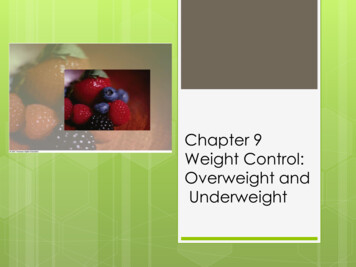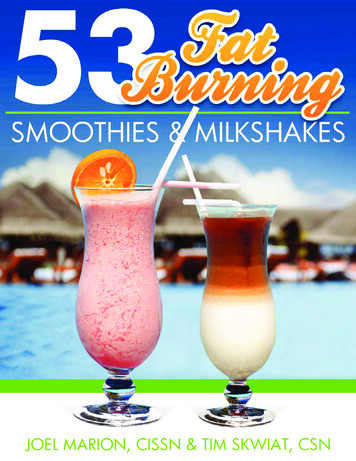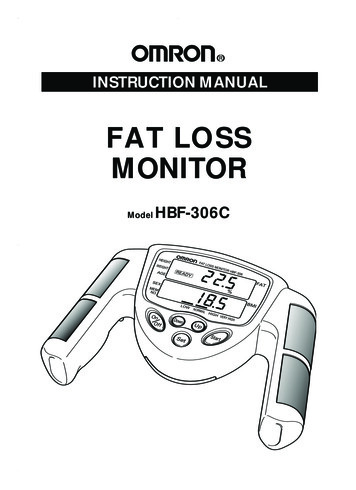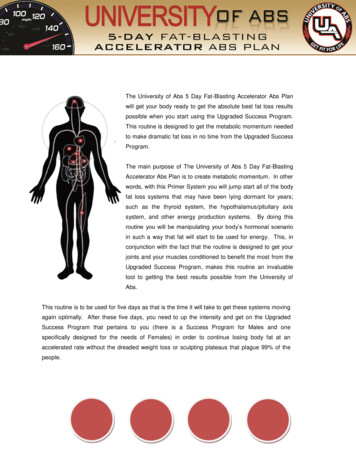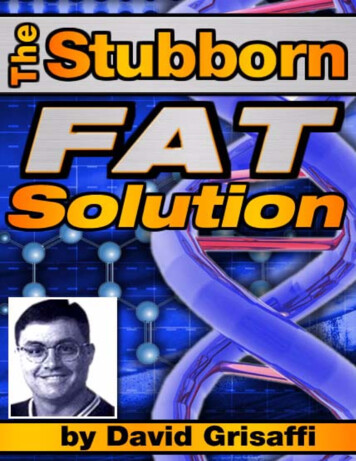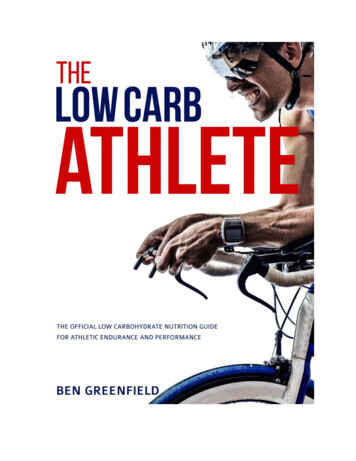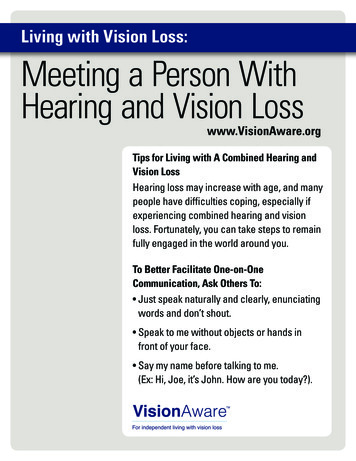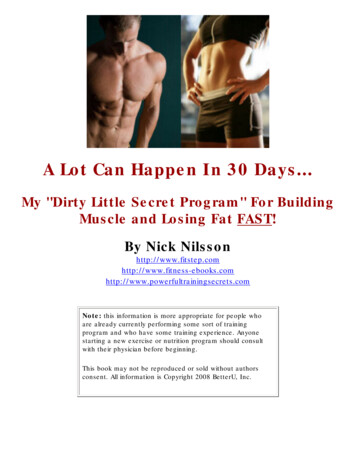
Transcription
A Lot Can Happen In 30 Days.My "Dirty Little Secret Program" For BuildingMuscle and Losing Fat FAST!By Nick : this information is more appropriate for people whoare already currently performing some sort of trainingprogram and who have some training experience. Anyonestarting a new exercise or nutrition program should consultwith their physician before beginning.This book may not be reproduced or sold without authorsconsent. All information is Copyright 2008 BetterU, Inc.
A lot can happen in 30 days The dream of everyone who trains is to lose maximum fat and build maximum muscle in theshortest period of time possible. While it is definitely possible to both lose fat and gainmuscle at the same time, in my experience, the best results come from concentrating onone major goal at a time.Let me put it this way: to lose fat, you need a caloric deficit. To build muscle, youneed a caloric surplus. If you try to do both at the same time, you may just remainexactly where you are! This is especially true if you're an experienced trainer. Beginningtrainers, since their bodies are rapidly adapting to exercise, can build muscle and lose fat atthe same time far easier.But the question before us is how do we maximize both fat loss and muscle gain, two verymuch opposing goals, in only 30 days?The key lies in working towards each goal in the same program but not at the exact sametime. To maximize fat loss, we will first start with a 5-day cycle of exercise and diet totallygeared towards fat loss. We will then immediately follow this with 5 days of exercise anddiet totally targeted towards muscle gain. We will repeat these 5-day alternating cycles 3times each, for a total of 30 days.Phase 15 DaysPhase 25 DaysFat LossPhase 35 DaysPhase 45 DaysFat LossMuscleBuildingPhase 55 DaysPhase 65 DaysFat LossMuscleBuildingMuscleBuildingWhile this may sound like you'll be jumping around too much in your training to really getresults, consider this: the body rapidly adapts to both fat loss and muscle gainprograms. When your body adapts fully, your progress can slow to a crawl.
We're going to take full advantage of yourbody's quick adaptation to training byswitching rapidly between two opposingprograms.If you're familiar with the ABCDE program(Anabolic Burst Cycling of Diet and Exercise)put forward in Muscle Media magazine anumber of years ago or TC Luoma's morerecent update of the program, this is a verysimilar concept.To illustrate my point, remember how quickly you gain weight when coming off a strict diet?Remember how quickly you lose weight when you start to diet and you haven't been carefulabout what you've been eating? That's your body rapidly adapting to a stress. One of themost powerful features of this switching back and forth is in the change itself - your bodychanges far quicker when you give it a powerful reason.What is the result of this switching back and forth? Extremely rapid fat loss andextremely rapid muscle gain.To maximize the effects of this switching, you must tailor your training, diet andsupplementation towards your specific goal during that time. Your bodyweight will fluctuatequite a bit as you go through the cycles but the end result will be decreased bodyfat,increased muscle mass and a new respect for the adaptive capabilities of the human body!The Fat Loss CycleIn order to achieve rapid fat loss, you need to target your training towards burningmaximum calories while maintaining as much muscle mass as possible. To accomplish this, Irecommend doing both cardiovascular training and weight training during your fat losscycle. When properly combined and targeted, weights and cardio can have spectaculareffects on fat loss.Here is a 5-day workout schedule to follow during your fat loss cycle. This gives you anoptimum combination of cardio training and weight training. I will explain in detail how thisprogram is put together and why it works as well give you recommendations about whattype of cardio training to do and when to do it in your workouts.
Day 1Back (10sets)Chest (10sets)Biceps (6sets)Calves (6sets)10-12reps/set30 sec restDay 2Shoulders (8sets)Triceps (8sets)Thighs (12sets)Abs (4 sets)10-12reps/set30 sec restCardioTrainingDay 3Day 4CardioTrainingBack (6 sets)Chest (6 sets)Thighs (6 sets)Shoulders (3sets)Biceps (3 sets)Triceps (3 sets)Calves (3 sets)Abs (3 sets)Day 5Rest5-7 reps/set30 sec restCardio TrainingProgram Notes: During all weight training sessions you will keep your rest periods very short (30seconds between sets) with your training volume relatively high. This will keepyour heart rate up, giving your body a cardiovascular workout while you're doing yourweight workout. It's very demanding and excellent for boosting the metabolism. Keepa timer handy or watch the clock to your rest periods consistent.Short rest periods, higher reps and higher volume have also been shown toincrease growth hormone levels in the body due to lactic acid build-up. Yourbody reacts to lactate (lactic acid) by releasing growth hormone. Growth hormone isvery effective at decreasing fat mass in the body. The result of the short rest andhigh volume and reps is that you're giving your body not only a hormonal fat-burningboost but a cardiovascular calorie-burning boost as well.Select exercises that will use the most muscle mass, such as squats, benchpresses, dips, etc. These exercises may be tougher but they'll burn the most calories,giving your metabolism a bigger boost and stimulating your muscles to a far greaterdegree.
For your workouts, the body is broken up into different parts over two days for thefirst two sessions. This is done in order to keep the training volume high for thosebodyparts. On Day 4, the training volume is lower for the bodyparts but every singlebodypart is worked. This allows you to work every bodypart twice during the cyclewhile still including a complete rest day on Day 5. The rest day is very important forrecovering from the exercise you've done this week.You'll notice that on the first two weight training days, the reps are somewhat higher(10 to 12 reps) than on the third, total-body weight training day (5-7 reps). This is aform of periodization known as microperiodization. In normal periodization, you movethrough cycles of rep ranges over a period of months - here we're doing it in periodof days. The body responds very well to short cycles like this. The first two daysfocus on higher reps to burn more calories and maintain muscle mass. The thirdsession focuses on heavy weights and lower reps to keep your strength levels high.The number of sets listed for each bodypart is the total number for you todo for that bodypart. You may choose to use only one exercise for all the sets ordivide the sets up between several exercises. For example, if the program calls for 10sets for back, you can do 10 sets of bent-over rows or you can do 5 sets of rows then5 sets of pulldowns or perhaps 3 sets of deadlifts, 3 pulldowns, and 4 rows.Cardiovascular training will be done three times during this 5 day cycle. Inthe next section, I will go into detail as to which type of cardio training to use formaximum results.On your rest day, be sure it is a total rest day! You're going to need it in orderto recover and get ready for the next phase of muscle building. This means noexercise sessions and limiting other physical activities. Get out of the gym and relax!Notes On Cardiovascular Training For Fat Loss:There are several ways to incorporate cardio into your fat loss regimen, depending on howmuch time you have available to you for your workouts.The preferred method for working cardio and weights is to do completelyseparate cardio and weight training sessions. The maximizes your energy level forboth so that they aren't competing with each other for resources during a single session.This improves performance during both types of workouts and improves the metabolicboost you get from training by increasing the frequency of exercise. You can do cardio inthe morning and weights in the afternoon or vice versa - whichever feels better to you. Forseparate sessions, the order doesn't matter.
If you don't have time to separate yoursessions, I recommend doing your cardiotraining AFTER your weights, not before.Here's why:When you first begin to exercise, yourbody relies heavily on storedcarbohydrates and blood sugar forenergy. As you progress in your workout,that mix gradually changes to increasedfat burning.You're doing cardio to burn fat andweights to preserve and build muscle.If you start with cardio, you decrease your blood sugar and glycogen levels, forcing yourbody to rely on fat to power your weight workouts. If you do weights first, you're using amore efficient fuel. Then, when you do cardio, you'll be dipping into fat stores much faster.This makes the process more efficient.That being said, if you prefer to do your cardio first, you're welcome to. The real keys tosuccess are consistency and intensity. If, by doing cardio first, you'll put more effort intoboth, do the cardio first.What Type Of Cardio To Use:The type of cardio I recommend for best results is high-intensity intervaltraining. This type of training will not only burn a lot of calories during the exercise, it willboost your metabolism very significantly for long after the session. This long-term boost isthe real secret to quick fat loss. Low to moderate intensity cardio simply doesn't give yourbody a kick like this.High-intensity interval training can be done anytime, anyplace, with any form of exerciseand on any cardio machine. The basic premise of this type of training is to go really hard fora short period of time then go really slow for a period of time to recover.A good example of this is sprinting on a soccer or football field. Start by sprinting the lengthof one side of the field. Walk slowly over to the other side then sprint all the way down tothe end again. Walk back to your original start position, then sprint again. Repeat this cyclefor several rounds.
Another example is on a stationary bike. Start by warming up with a short, slow ride for afew minutes. Kick the intensity up to a high level for 30 seconds and go as hard as you can.Drop the intensity back to a very low level for 30 seconds, then repeat.These are several basic examples. You can follow an interval program programmed onto acardio machine or you can design your own based on the simple outline of alternating fastand slow periods. Don't be afraid to push yourself!For best results, I highly recommend using High Intensity Interval Training for the cardiotraining that is included in the program listed at the beginning of this section.Notes On Weight Training For Fat Loss:Weight training is an extremely important aspect of fat loss. Your metabolic rate is verymuch determined by the amount of muscle mass you carry. The more muscle youhave (and keep!), the faster your fat loss will be.The major modifications I recommend when it comes to weight training for fat loss are adecrease in rest periods between sets and an increase in training volume. As I mentioned inthe Program Notes section, the result of short rest periods, combined with higher volumeand moderately high reps is increased growth hormone secretion due to lactic acid build-up.This is very effective for losing fat quickly!Many trainers make the mistake of only using muchlighter weights and much higher reps when weighttraining for fat loss. All this does is decrease thestimulus on your body for keeping muscle mass!Continue to train with heavy weights and moderaterep ranges (e.g. 6 to 12 rep sets). Your body needs toknow you still want to keep your muscles big andstrong!Many trainers also make the mistake of dramaticallyramping up their training intensity and throwing inadvanced intensity techniques in an effort to increasemuscle definition. While including a few intensitytechniques (such as supersetting, where you do twoexercises back to back) is okay, relying on them fordefinition will overtrain you in a hurry.
Think about it this way your body is in a caloric deficit and struggling to hang onto muscle.Why overtax your reduced recovery ability (it's been reduced through dieting) by breakingdown your muscles even more than you do when your recovery is actually greater? You'lljust end up burning more muscle tissue and beating yourself up. Greater musculardefinition will come from burning off excess fat, not from doing drop sets onevery set.How To Eat and Supplement For The Fat Loss Phase ofTraining:Now that we know how to train for fat loss, we need to know how to eat for fat loss.To maximize the fat loss phase of this program, there are two basic approaches you can usefor your diet: low-carb and low-fat.Of the two, the fat loss diet I recommend is the low-carb approach. A full discussionof the positives and negatives of this approach to eating is beyond the scope of this articlebut, properly done (not as sensationalized in the popular media, i.e. bacon and butter inevery meal), this type of diet can be very safe and effective for fat loss.The reason I recommend the low-carb approach is that our goal with this program ismaximum change. Taking carbs out of your diet is a huge change. When you add carbsback in for your muscle-building phase, your body will react with a tremendous surge innutrient absorption, increasing your muscle mass at a very rapid rate.The low-carb diet, by removing your body's preferred source of fuel (carbs), forces yourbody to rely far more on stored bodyfat for energy. Your body becomes more efficient atburning fat when forced to rely on it for energy. Your insulin levels will level out, your bloodsugar will be more stable and you won't get cravings or hunger pangs like on a regular, lowfat diet.Lower insulin levels and stable blood sugar make it far easier for your body to use bodyfatfor energy. When insulin is present in quantity, your body will tend to store nutrients, notburn them.
If you prefer not to eat a strict low-carbdiet, you can certainly eat a moreconventional low-fat diet.I would still highly recommend reducingyour carb intake, however, to maximizethe effect of the change in diet whenyou move to the muscle-building phase.A very effective approach to the low-fat diet is what I call "Carb Tapering." Thebasic idea of it is simple: reduce your carbs as the day goes on. Your first meal of the dayshould contain the most carbs, with a reduction in carbs in every successive meal after that.Your final meal of the day should contain few, if any, carbs.The reason this approach is effective is that your body simply doesn't need as many carbsas the day goes on. Activity levels are generally lower and your metabolism is naturallyslowing down. Reducing your intake of energy foods later in the day will help prevent yourbody from storing the meals you eat later in the day.Returning to the low-carb approach, when you eat low-carb, you'll need to eliminate foodssuch as pasta, potatoes, rice, bread, cereal, fruits, juices, etc. You'll be focusing on meat,poultry, eggs, healthy fats (e.g. olive oil, fish oil, flax oil, etc.) and plenty of salads andvegetables. Limit yourself to less than 30 grams of total carbs over the course of the entireday. It's important to eat the vegetables and salads to be sure you're getting the nutrientsyou need.Many people have a distorted view of low-carb diets, believing they're a license toeat bacon and butter for every meal. NOT TRUE! A healthy low-carb diet should focus onleaner cuts of meat, plenty of vegetables and greens, and healthy fats, NOT highlysaturated fats such as bacon and butter. While it's true you can more easily get away witheating such foods on a low-carb diet, they should not be eaten regularly or a staple of thediet.Keep your calories at a fairly low level during this phase so that you stimulate fat-burningbut not so low that you slow your metabolism or end up burning muscle mass. A good ruleof thumb is not to go lower than 1200 to 1800 calories per day, depending on your currentmuscle mass levels. The more muscle mass you carry, the higher on the range you'll needto be. This applies both to low-carb dieting and to traditional low-fat dieting.
Your protein levels should be at least 1 gram per pound of bodyweight (this level is not hardto reach when you're eating lots of meat and eggs) to maintain maximum muscle mass.When you do the low-carb diet for the first time, you may experience some dizziness orlight-headedness. Avoid operating heavy machinery or motor vehicles if this happens. Thisfeeling will disappear as your body becomes more accustomed to burning fat for energy. Bevery certain to take a good multivitamin during your entire program - its nutritionalinsurance and should be in every supplementation program. A fiber supplement is not a badidea either (it will help keep your digestive system "moving").Also, since the foods you will be eating during this phase contain very little potassium(which is an extremely important nutrient), it is highly recommend to include a potassiumsupplement as well.Fat Loss Supplementation:As far as supplementation goes, I believe in keeping it basic. There are a number ofeffective fat loss supplements on the market but, in my opinion, a good multivitamin,calcium supplement, protein powder and glutamine powder will cover the majority of yourbody's needs in a fat loss program. The real power of the program lies in the exercise andnutrition aspects.For the purposes of this program, creatinemonohydrate intake should be eliminated during thistime.Don't take any creatine at all during this phase of theprogram. In fact, if you can be off of it for at least amonth before beginning this program, you'll get evenbetter results.The reason I recommend staying off creatine is this:when you make the switch to a higher-carb, musclebuilding diet, you can load up on creatine. Your bodywill take up far more creatine if you've been off of itand if you've been keeping your insulin levels lowthrough eating low carbs.That being said, some people may not be interested in taking creatine due its waterretaining properties or simply may not be able to take creatine because it doesn't agree withthem or there may be other reasons. It's important to note that not taking creatine will not
adversely affect the results you get from this program. Using creatine can can certainlyadd to the results you get in the muscle-building phase but it's not absolutelyessential for success.This covers the 5-day fat loss cycle of our program. Now we'll move to the 5-day musclebuilding phase of the program. Your training and eating will change dramatically and yourbody will react by piling on muscle mass!The Muscle-Building CycleYour body has just been through 5 days of calorieand nutrient restriction, high-volume, short-resttraining and intense cardio training. It's now primedfor muscle growth! You're going to go in thecomplete opposite direction with your training andnutrition, focusing on plenty of food, longer restperiods, reduced training volume and no cardiotraining.Here is a program to follow during the 5-day musclebuilding phase.Day 1Back (5 sets)Chest (5sets)Biceps (4sets)Calves (4sets)9-12 reps/set1.5 min restDay 2Shoulders (5sets)Triceps (5 sets)Thighs (7 sets)Abs (3 sets)8-10 reps/set1.5 min restDay 3Day 4Day 5RestDayChest (3 sets)Back (3 sets)Thighs (3 sets)Shoulders (2 sets)Biceps (2 sets)Triceps (2 sets)Calves (2 sets)RestDay6-9 reps/set2 min rest
Program Notes: When you work through your 5-day muscle-building cycle, you won't be doing anycardiovascular training. Every ounce of food and recovery energy should be goingtowards building muscle. This includes outside activities. If you can minimize othercalorie-burning activities, such as intense sporting activities or heavy labor, you'll getbetter results (you don't need to lay on the couch all day, however!).Your training will focus on heavy weights and basic exercises to maximallystimulate your muscles during this phase. The rep range we will be focusing on willbe between 6 to 12 reps per set. The exercises we will be using include squats,deadlifts, bent-over rows, bench press, shoulder press, barbell curls, dips, close-gripbench press, stiff-legged deadlifts, leg curls, leg press, etc. The idea is to selectexercises that use the most amount of muscle mass. These exercises are the best forstimulating rapid growth and nutrient uptake in the muscles.Workouts should last between 45 minutes to an hour at the most. If you liftmuch longer than this, your body will have a harder time recovering from thetraining. You want to break the muscles down but not so much that you can't recoverquickly enough to train again soon.Rest periods should be longer than during the fat loss cycle. I recommend atleast 1½ to 2 minutes rest in between sets to help keep your strength levels upduring the workouts.The rep ranges are microperiodized, just like in the fat loss cycle, starting with thehigher reps then moving to the lower reps. This is a very efficient training techniquefor your body to gain strength and muscle mass.The last day of the cycle is a complete rest day - this is placed here to give yourbody a bit of a break before you restart the fat loss cycle again.Nutrition and Supplementation for Muscle Building:We've looked at training, now let's look at your eating during your muscle-building phase.Your two main focuses should be on total calories and increased protein intake. Your caloricintake should increase dramatically during this phase. Building muscle requires an excess ofcalories and substantial amounts of protein. I'm not saying this should be a see-food diet(see food, eat it) where you eat absolutely anything that's in front of you but you shoulddefinitely be eating a lot.
Caloric Intake:Eating enough total calories to support muscle growth is absolutely critical tosuccess. In fact, not eating enough is probably the single greatest reason many peoplesimply never reach their muscle-building goals. How much a person needs to eat in a daywill differ dramatically between individuals. Some people will require far more food to makegains than others.Here's the rule of thumb that I like to follow formaximum results with this program: eat as much andas frequently as you can. It's really quite simple! Tryto aim for at least 5 meals a day at the very least.But if you eat all you can, won't you gain backall that hard-earned fat loss?Here's the beauty of this "rapid-change" program.You've been dieting strictly for the past 5 days andtraining hard. Your body is quite literally begging fornutrients. When you start feeding it, it's going torespond by rapidly filling up your muscles withnutrients and water, not with fat stores.The muscle-building hormones in your body are going to be working overtime to bounceback from the self-inflicted famine you've just been through. The short 5-day window inwhich you'll be operating is not enough time to add substantial fat back on your body,especially since you'll be training hard to maximize muscle gain. The result of this feast?Your body will preferentially pile on muscle mass, not fat.This rebound effect is amplified by utilizing the low-carb diet, as explained in thefat-loss section above. When you're eating very few carbs during the day, your bodyresponds to this by secreting very little insulin (the primary nutrient-storage hormone in thebody). This works in favor of fat loss by allowing your body to liberate fat stores (wheninsulin is present in the blood, nutrients are primarily stored, not burned).When you switch to a higher-carb diet, the lack of insulin from the low-carb phase hassensitized your body to its effects. When you eat carbs again, your body is going to be farmore sensitive to the effects of insulin, which will allow you to store more nutrients moreefficiently. This is the main reason people gain weight so quickly when coming off a low-
carb diet. You can very easily make it work in your favor for muscle gain.If you haven't done the low-carb diet, you will see a rebound as a result of increasing yourcalories from a lower level but you won't see as great of an effect as you would if you wereeating the lower-carb diet. You will still get results, but they won't be as dramatic, which iswhy, if you can, I recommend the low-carb diet during the fat-loss phase.What you eat is very important. Don't be afraid of eating foods with fat in them butdon't base your diet on them. Foods that have been through as little processing as possiblewill be your best choices. Your body has a far easier time digesting and utilizing thenutrients in unprocessed foods than it does with more processed foods.When it comes to exactly what you should eat, you'll have to be the judge of that. Whatworks (and tastes good) to one person will not work (or taste good) to another. The realkey is quantity. You must give your body enough calories to support the muscle-buildingprocess or you won't get maximum results. As with the training during this phase, youreating is something you can experiment with. Eat different things and different amountsand record how they affect you and what results you get from them.Protein Intake:Your next focus should be on protein intake. To build muscle, your body needsprotein. There are plenty of opinions on how much protein you should take but, in myexperience, the best rule of thumb is one gram per pound of bodyweight, minimum, e.g. ifyou weigh 190 pounds, eat 190 grams of protein per day.This protein intake is best accomplished with acombination of food and supplementation.Good protein-containing foods include lean meats, fish,poultry, eggs, soy, legumes, and dairy products. Makesure you eat protein-containing foods in every meal tomaximize growth and provide a steady stream ofprotein to your muscles.Whey is the single best protein supplement to take,though there are many powders that also include milkprotein to slow the absorption of the whey (wheydigests relatively quickly, milk protein is much slower).
A slower absorption means protein is trickled into your system over a longer period of time,which can help with keeping your muscles fed with protein more continuously. A fasterprotein (e.g. whey) is good for times when your body needs protein quickly, such as after aworkout.There are a number of best times to take your protein supplement. Here they are in orderof importance:1.2.3.4.5.6.7.Immediately after a workoutOne hour after a workoutFirst thing in the morningLast thing before bedBetween mealsWith mealsIn the middle of the nightCreatine Monohydrate:Now we turn to creatine monohydrate. This supplement is optional but it is extremelyeffective, especially in this phase of this particular program. If you followed my advice fromthe previous section, you will have been off creatine for at least the previous 5 days andhopefully longer than that. Being off creatine for at least a month before will ensure you getthe most bang for your buck in this phase as your creatine levels will be back to normal.During the first 3 days of this 5-day period, you'll be doing a creatine load. You'lltake 5 grams of creatine 4 times a day for the first 3 days ONLY - we want to get the fastinflux of water and nutrients but, since we're going to reload creatine again the next cyclethrough, we want to leave some room for the next round of creatine to be absorbed.Now, creatine in a normal program is very good. When you take it in combination with this"rapid-change" program, it can result in extremely rapid progress!When you switch from a low-calorie, low-carb diet, your body is hungry for nutrients andmore sensitive to the effects of insulin. Creatine is absorbed more efficiently when insulinlevels are high. By taking your creatine after coming off a low-carb phase, your body willtake up more creatine than even during a normal loading phase. The supercompensationeffect can result in up to 10 pounds of weight gain in only one day!When you're back on the low-carb, low-calorie diet, you'll be off creatine again.
Other Supplements and Water Intake:Glutamine is also an excellent supplement to add to this phase. Glutamine is a conditionallyessential amino acid that is very important for the immune system, recovery, and musclegrowth. It also helps the muscles absorb more water, which is very useful for this phase. Iwould recommend loading up on glutamine by taking 5 to 10 grams 4 times a day for thefirst 2 days of the muscle-building program then 10 grams twice a day for the last 3 days(once post-workout and once just before bed). This glutamine loading can be repeated oneach muscle-building phase.As always, be sure you are taking a good multivitamin during all phases of training. Thisshould be in your supplementation program at all times. Calcium, magnesium, and VitaminC are also very helpful. Though I mentioned potassium as an important supplement in thefat loss phase, you should be able to get plenty of potassium in the foods you're eating inthis muscle building phase.It is absolutely CRITICAL that you drinkplenty of water during this phase.When I say CRITICAL, I really mean it! Your bodyis rapidly taking in carbs and protein (and possiblycreatine and glutamine). These nutrients needplenty of water in order for your body to take fulladvantage of them.Drink whenever you think of it. Keep a waterbottle handy at all times so you can drinkregularly. Do whatever you need to do to remindyourself to drink. This can make or break thisphase of the program. The more you drink, thegreater your results can be![Note: caffeine-containing beverages such as sodas, coffee and tea should be limited and,if possible, eliminated during this phase. Caffeine is a diuretic and will flush much-neededwater out of your body.]After going through 5 days of muscle-building targeted eati
Muscle-Building Muscle-Building Muscle-Building While this may sound like you'll be jumping around too much in your training to really get results, consider this: the body rapidly adapts to both fat loss and muscle gain programs.

